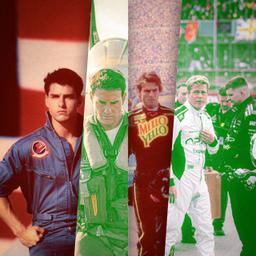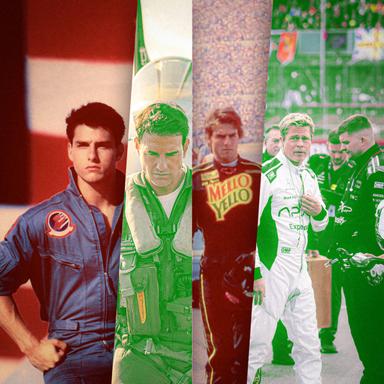In F1: The Movie, Brad Pitt plays Sonny Hayes, a wizened former Grand Prix prodigy wandering the world in search of freelance wheelman gigs. Like a lot of guys his age, Sonny’s looking for a shot at redemption; he finds it by hooking up with his old pal and former rival Ruben (Javier Bardem), a more conventional type who’s leveraged his career winnings into a new startup racing team called APXGP. Ruben’s company is ethical, cutting edge, and potentially very profitable; the problem is that his drivers—including hotshot recruit Joshua Pearce (Damson Idris)—don’t seem capable of steering themselves anywhere near the podium.
At first, Sonny makes a show of his own reluctance, growling the usual roughneck platitudes about not being in it for the money and needing to keep things real. That’s how people talk in F1. Later on, we’re told that Sonny is not a has-been but a never-was, one of many lines in Ehren Kruger’s script that splits the difference between Jack Handey’s “Deep Thoughts” and ChatGPT. Chances are that if you’ve ever seen a movie before—it doesn’t even have to be Days of Thunder, although that’s the template here—you know where this is headed. Sonny shows up in APX’s trackside paddock and immediately makes an enemy of Pearce. They’ll have to learn how to work together, off the track and on it; the question is who will shake and who will bake.
Seasoned moviegoer that you are, you can also probably guess that Sonny will: struggle with his demons (maybe even in the form of flashbacks to the crash that broke his body and spirit); seduce APX’s testy technical director, Kate (Kerry Condon), despite her stated policy that she never hooks up with coworkers; and teach the young, untested, ragtag pit crew some dirty tricks to level the playing field against their established, deeper-pocketed competitors. Will he also make a big, rousing speech about why driving makes him feel free and how time slows down at top speed? You know he will. There are no points for getting ahead of a movie like F1, which, for all its kinetically rendered daredevilry, is basically the cinematic equivalent of a pace car designed to help the audience keep up.
At this point in his career, Pitt can play faded alpha males like Sonny Hayes in his sleep, and he comes close here in a performance that’s so relaxed it seems sedated. The first time we see Sonny, he’s napping in between laps at a 24-hour endurance race where he receives the princely sum of $5,000 for his participation; sadly, Shea Whigham is in the film only long enough to cut the check. Pitt is by far the biggest name in F1’s cast, but even though he appears in nearly every scene, he isn’t the film’s real star. That’d be the logo for Expensify, a publicly traded software company that decided it was ready for its close-up and invested heavily in the project, anticipating a brand boom based on sustained, IMAX-sized exposure.
Such shameless clout chasing is endemic to a sport whose stars literally wear their corporate fealty on their sleeves, and F1—which was produced in close collaboration with the Fédération Internationale de l'Automobile and features cameos by several racing icons—offers a plausible, lived-in depiction of a world where big-name sponsorships attract celebrities and drive innovation. The metrics testifying to Formula One’s global popularity would seem to justify the film’s reported budget of $300 million, although producer Jerry Bruckheimer insisted last summer that the figure had been inflated. “We can’t give you a number because that’s Apple’s money,” he explained, sounding like he was auditioning for a cameo on The Studio. However much F1 cost, the money is, as they say, on the screen. Here, “Expensify” isn’t just a brand name. It’s a guaranteed imperative.
Three summers ago, director Joseph Kosinski distinguished himself as one of the most gifted big-scale entertainers around with Top Gun: Maverick, a movie that worked spectacularly well as a slick, adrenaline-pumping exercise in product placement. Its sales pitch was two-pronged, pushing both the idea of the United States Navy as a big, happy family whose members play double ultimate football on the beach to build trust (and abs), and also the idea of Tom Cruise as the great American movie star, if not American Cinema Incarnate. A lot of F1 plays like an earthbound replay of Maverick: an attempt to make an old-fashioned (or at least extremely ’80s) populist blockbuster on 21st-century terms.
Certainly, APX’s expert staff of gearheads—working round the clock with all kinds of physical and virtual resources—seem more like military contractors than mechanics. (At one point, the pit crew starts chanting “combat.”) Both of Kosinski’s films thematize the desire to be the best in the world: the fastest, the cockiest, the bravest. But where Maverick achieved liftoff, F1 spends an awful lot of time spinning its wheels—albeit as authentically as possible. The proliferation of articles celebrating the cast’s proficiency at actually learning how to pilot Formula Three and Two challengers makes for good copy, but it also explains the unusually fluid continuity in F1 between wide-scale track views—achieved with a mix of location shooting, stunt driving, and CGI—and driver’s seat GoPro close-ups. The stress in the actors’ eyes as the characters shift gears and lean into turns is real, yet the credibility of the racing sequences doesn’t do much to mitigate the lazy, shameless clichés of the script (by the reliably hacky Kruger). If anything, it exacerbates them.
Of course, there were also plenty of clichés in Maverick (which was cowritten by Kruger), but Kosinski was able to inflate them so that they felt like archetypes. It helped that Cruise was playing smartly with his personal mythology as well, proving that he could hang with cool kids like Glen Powell while essentially giving them some shine. There is, admittedly, a little friction in seeing Sonny scroll through YouTube clips of his younger self, but at best, the images of a smoothed-out, surfer-coiffed Pitt recall The Curious Case of Benjamin Button—a movie that deals with aging and mortality in a much more challenging way. Sonny’s aging-comeback-kid shtick is entirely prefab, and he’s never really challenged or thrown for a loop; the whole thing is basically an extended victory lap. Idris holds his own without ever really nailing down the source of Josh’s cockiness—the best the movie can do for character development is to give him a steadfast single mom and a scene in which he realizes that social media is basically evil—while Condon, a brilliant actress, ably recites her gearhead dialogue and smiles indulgently at Pitt. The one actor who seems to be having a good time is Bardem, all solemn, smoldering decency, but Ruben is an absurd character—a benign, good-hearted multimillionaire trying to make an honest buck. The only thing at stake in F1 other than a few trophies and endorsement contracts is a wealthy man’s bank account; at least in Major League—which F1 oddly resembles—the point of all those prankish underdog antics was to stick it to management.
It’s this sense of technocratic complacency—of pushing the stylistic envelope while otherwise embracing the status quo—that defines F1, and not for the better. Nobody is expecting a studio tentpole production that cost $300 million (or whatever) to be a subversive critique of late capitalism, but the movie is ultimately so deferential toward the sport and its ruling class that it comes off as kowtowing. There’s no real engagement in the script with Formula One’s history of scandal and tragedy (name-checking Ayrton Senna doesn’t count, especially in a movie that sanitizes its crashes) and no reckoning with how some drivers have been moved to protest racing in countries with histories of human rights violations. The finale takes place in Abu Dhabi, depicted unironically as a luxury-class paradise; crucially, we’re never with the ticket-buying fans, only the velvet-rope VIPs, who seem to be having a great time. Compare F1 to a thorny, ambivalent drama like Michael Mann’s Ferrari, which directly links its namesake’s drive to succeed to devastating flurries of emotional and physical violence. Kosinski’s vision is also less trenchant than that of Talladega Nights, which had the good taste (and guts) to skewer Formula One’s obsession with branding while linking it to larger ideas about American exceptionalism. Pitt’s presence also can’t help but recall Moneyball, a movie that tried to say something about baseball’s shifting values. F1’s message—blared loud and clear at all times—is that Formula One is fantastic.
The closest thing that F1 has to a villain is a greedy APX board member, Peter Banning (the ever-unctuous Tobias Menzies), a weasel in a suit with designs on stealing the company out from under Ruben. He, of course, tries to recruit Sonny for his plans, including a sweetheart offer of money beyond his wildest dreams; Sonny, of course, says no and—in a crowd-pleasing moment—flips him off via text message for good measure. The audience I saw F1 with gave Sonny’s emojified “fuck off” a good cheer, but as Peter scuttled back to his luxury box to watch the final race, I actually felt bad for him. He’s an asshole but also an ideal avatar for the streamlined, soulless movie around him.

